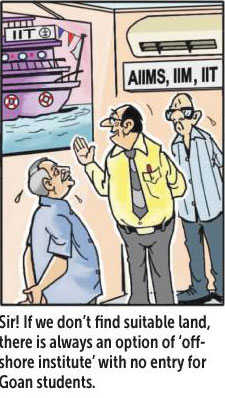18 Oct 2015 | 07:23am IST
A CENTENNIAL MEMORIAM
Altino Ribeiro de Santana – this name will live forever as part of history, not just of Goa, first as part of the ‘Estado da India Portuguesa’ and then as part and parcel of the Indian Union, but also of Angola and Mozambique, then Portuguese colonies and now independent countries.
By Teresa Colaço
Born in the village of Porvorim, Socorro, Taluka of Bardez, Goa, on 19th October, 1915 to Dr. Graciano André João Ribeiro de Santana and Rosa Maria Carmela Rodrigues Chicó, 8th in order of filiation, Altino Ribeiro de Santana after his primary studies, decided to dedicate his life to Christ, entering the Seminary at an early age. He was ordained a Priest on 9th October, 1938 and after having served as Assistant Parish Priest and Military Chaplain, earned the degree of Doctor in Theology from the Gregorian University at Rome. He served in the capacity of Professor at his Alma Mater – the Rachol Seminary and also as the first Rector of the Minor Seminary at Saligão in Goa. At the young age of 39.7 he became the first Priest from the Archdiocese of Goa to be appointed Bishop and was consecrated as such on 23rd October, 1955 at the Sé Cathedral at Old Goa. Here I recall my mother telling me that his proud mother who once upon a time when asked by someone why he became a Priest and replied that you have to give the best to God, was present on this joyous occasion. This showed her unselfish love and no regrets.
Meanwhile on 27th July, 1955 Pope Paul VI (now Blessed) created the Diocese of Sá da Bandeira in Angola. Most Reverend Bishop Altino Ribeiro de Santana was appointed its first Bishop and served the people of his Diocese as a true missionary, faithfully and tirelessly and was very much loved by them. Often during his pastoral visits he drove his jeep to the remote areas of his Diocese to tend to those in need and uplift them. He was at Sá da Bandeira from 9th January, 1956 to the beginning of 1972 when he was appointed Bishop of the Diocese of Beira, Mozambique, on 19th February, 1972. Here too he shepherded and served his new flock in the same manner. He had arrived in Beira at the height of the crisis of the ‘white’ Priests of Macuti case and this was where he lay down his life on 27th February, 1973, barely a year since he had taken over. His life and his work were cut short by the regime in power then for as Pastor having dutifully defended 2 such ‘white’ Priests accused of crimes against the State security and he died a real martyr for his Lord of a massive cardiac arrest days after a bomb was used to frighten him outside his residence where the 2 Priests were sheltered. His first heart attack had come during the course of a break in the judicial hearings but after recovering he testified in the Court. After his body was buried in Beira, later on the people of Sá da Bandeira asked that his mortal remains be brought to their city where he had lived 16 long years amongst them, enriching their lives. This was done on 4th April, 1974 and the mortal remains placed in the Cathedral of Lubango (new name of Sá da Bandeira). During his posting at Sá da Bandeira, Bishop Altino Ribeiro de Santana attended the 2nd Council of the Vatican at Rome on 11th October, 1962, participating in the deliberations held therein. The Municipal Council of Lubango (old Sá da Bandeira) corroborated the request of its people and as a tribute to the memory of their most loved Shepherd of happy memories, a City road was named after him.
Bishop Altino Ribeiro de Santana was an epitome of gentleness, simplicity, affable to a fault, self-giving, loving, caring, humble, courageous and above all a great human being and humanist who gave his best, be it to the Church, his people or his family. After having being abroad for a long span of time of about 14 years, Bishop Altino returned to Goa – his motherland in 1970 to see and meet with his siblings and their families. I remember we had a big family reunion at the ancestral house at Porvorim and some of the memories are still vivid in my mind. Alas, nobody could have guessed that this would have been his last visit to the Goa and his family which he loved so dearly. Though we miss him greatly, we have very dear memories of his work done etched in photographs as well as on a big elephant tusk uniquely carved by the people of Angola which has been donated by his family to the Museum of Christian Art at Old Goa and has been displayed there for posterity.
At the end I say to you, WELL DONE T.ALTINO. We are proud of you at 100 and we salute you! Your memory will live on forever.
(The author is the Grand-niece of Most Rev. Bishop Altino Ribeiro de Santana)
